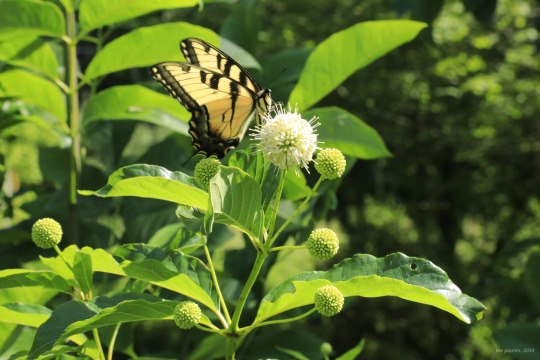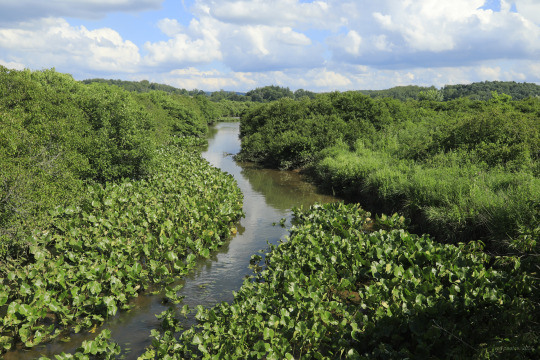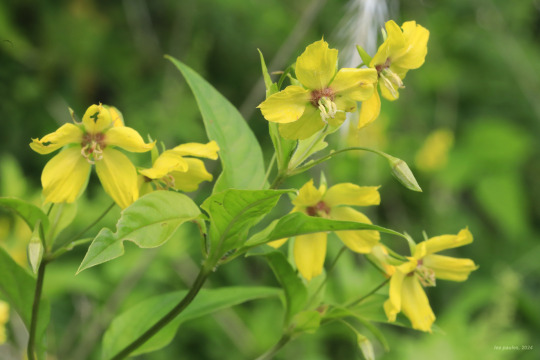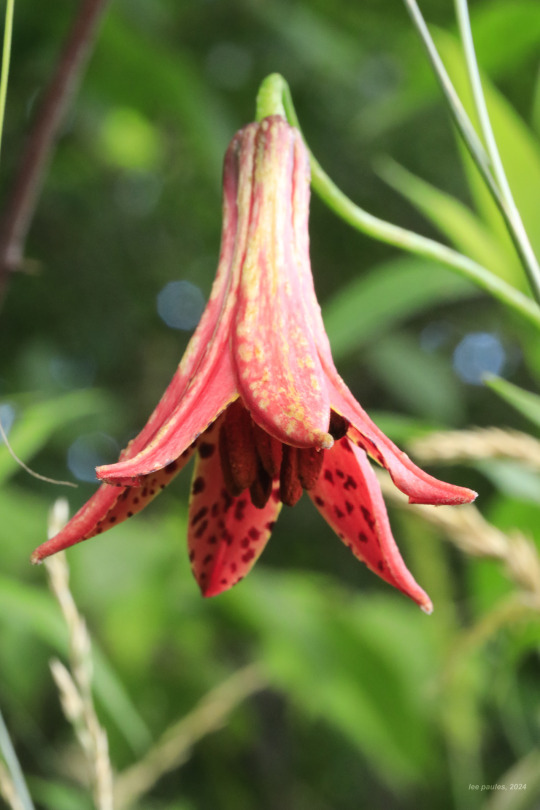#Common Buttonbush
Explore tagged Tumblr posts
Text





















Summer has arrived, and with it, the single greatest proliferation of life in Central Appalachia. This is the time of great, ostentatious wildflowers, one more showy and resplendent than the next, each competing with the other for the swarms of pollinators that have emerged to drink from the earth's sweet nectar pots, find their mates, and plant their eggs in the all-too-brief span before their whirring energies have faded into oblivion. At no time do I feel more connected to life's urgent, relentless pulse than in the electric heat of summer; the rich meadows, bogs, streambanks, and hedgerows are my temples and the tiny creatures that come to them to feed and renew their kind are the only intermediaries I need to realize true spiritual peace and joy.
The photos above are from a late afternoon bike ride on Deckers Creek Trail.
#appalachia#vandalia#west virginia#wildflowers#flora#deckers creek trail#common buttonbush#honeybells#tiger swallowtail#king of the meadow#tall medow-rue#starry campion#whorled catchfly#wild bergamot#fringed loosestrife#white meadowsweet#butterfly milkweed#swamp milkweed#rose milkweed#common milkweed#large milkweed bug#common roadside skipper#banded hairstreak butterfly#hummingbird clearwing moth#swamp rose#canada lily#tall thimbleweed#bumblebee#insects#joy
186 notes
·
View notes
Text















A lot of cool plants and some invasive grasshopper nymphs
#Common Buttonbush#Bent Alligator-flag#Sensitive Plant#Peruvian Primrose-Willow#American Groundnut#Lubber Grasshopper Nymph#Bald Cypress#Allegheny blackberry
0 notes
Text
wait common ninebark is a native that looks really cool.

it's like a cross between a mountain laurel and a buttonbush.... (pics of both for reference)


really really handsome and interesting flower..........
13 notes
·
View notes
Text

COMMON BUTTONBUSH FLOWER (also named button-willow, buck brush, and honey-bells) - Composition Friday
© Erik McGregor - [email protected] - 917-225-8963
#PhotoOfTheDay#buttonbush#HoneyBells#BuckBrush#ButtonWillow#flower#shrub#CephalanthusOccidentalis#CommonButtonbush#shrubs#flowers#spring#SpringIsHere#wildflowers#floweroftheday#nature#TinyNature#wildlife#IntoTheTrees#IntoTheWoods#WalkInTheWoods#hiking#SterlingLake#SterlingForestStatePark#SterlingForest#NewYork#flowersofinstagram#FlowerPhotography#NaturePhotography#ShotOnNikon
5 notes
·
View notes
Text



Cephalanthus occidentalis- Common Buttonbush
NE US natives, and just the cutest things :)
2 notes
·
View notes
Text


Cephalanthus occidentalis - Common Buttonbush
7 notes
·
View notes
Text
Do We Have a Ceasefire? Or Will Other Nations Hand Iran a Nuke?

Philip C. Johnson - June 23, 2025
As of June 23, 2025, the Middle East is still a tinderbox, despite President Trump’s evening announcement of a “complete ceasefire” between Israel and Iran. Ceasefires in this part of the world are like cheap New Year’s resolutions; often broken by breakfast. With Iran’s nuclear program bruised, 400kg of enriched uranium on the loose, and whispers of Pakistan eyeing a nuclear handoff, let’s cut through the fog with a cynical squint.
U.S. Strikes: Fordow Obliterated? On June 21, U.S. B-2 stealth bombers unleashed 30,000-pound bunker-busters on Iran’s Fordow, Natanz, and Isfahan nuclear sites, per Reuters. Trump boasted they were “obliterated.” Maxar imagery shows six craters at Fordow’s entrance, debris scattered like a warzone yard sale. Pentagon’s Gen. Dan Caine claims “extremely severe damage.” IAEA’s Rafael Grossi expects “very significant damage” but can’t confirm underground impacts; no radiation leaks have been detected.
Iran, true to form, peddles their own version of reality. State-run IRNA admits Fordow was hit but claims it was evacuated with minimal damage. MP Mohammad Manan Raisi calls it surface scratches, fixable. Iran’s atomic agency brags 400kg of enriched uranium (a heart-stopping amount) was moved pre-strike. X’s @osc_london notes Iran prepped Fordow’s tunnels prior to the U.S. strike, suggesting a tip-off. So, obliterated? Nope. Crippled? Likely. Staged for the news cycle? Obviously.
Iran’s Retaliation: Qatar and Israel Earlier today, the conflict continued with Iran launching missile attacks targeting Israeli cities. And, in a direct response to the U.S.’s strikes on Iran’s nuclear facilities, Iran fired 15 missiles at Qatar’s Al Udeid Air Base, a U.S. hub, per Reuters. Thankfully, there were no U.S. casualties. X’s @sentdefender calls Iran’s retaliation theater with Iran stretching its thinning arsenal for optics. And it certainly seems as if all of this was choreographed so that Iran’s leadership could retain a shred of dignity without forcing President Trump to respond, escalating the conflict.
Ceasefire: Will It Hold? Trump’s “complete ceasefire” announcement tonight aims to cool tensions after Iran’s Qatar and Israel strikes. Israel and Iran reportedly agreed, but history screams skepticism. Ceasefires in this neighborhood often collapse under ego and ambition. Iran’s 400kg of unchaperoned enriched uranium looms like a rogue missile, ready to reignite chaos. I, like most others, are praying for peace. But time will tell.
Pakistan Nukes for Iran? Gossip, Not Gospel No evidence backs claims of anyone slipping Iran a nuke, but Pakistan’s name keeps popping up. PM Shehbaz Sharif, after talks with Iran’s President Pezeshkian, slammed U.S. strikes as “illegal” on June 22, per PBS, despite nominating Trump for a Nobel Peace Prize. X’s @MarioNawfal says this shows diplomatic cuddling, but not nuclear deals. Mahyar Tousi on Tousi TV links Pakistan’s Iran sympathy to anti-Western gripes but doubts they’d court global suicide. Tim Pool’s June 22 podcast notes Pakistan’s nukes are U.S.-monitored. Iran’s proxies, Hezbollah and Hamas, are battered, and Pakistan is not suicidal.
Global Games Russia and China decry the U.S. strikes as illegal. Turkey bashes Israel but winks at Iran. Saudi Arabia and UAE quietly cheer the U.S. and Israel for doing their dirty work. And Europe pleads for calm, per the BBC. Nobody’s openly offering Iran nukes. Not yet.
At the End of the Day… Fordow’s limping, not dead. Iran is posturing but low on ammo. Pakistan’s sympathetic, not insane. Trump’s ceasefire is a gamble - his base hates endless wars, but Iran’s 400kg uranium wildcard could blow it all up. Nobody wants a nuclear Iran, except Iran, who’s playing a high-stakes game. The world watches, popcorn ready, as the Middle East prepares for its next episode in a drama series nobody really wants to watch. But we’ve already watch season one, so, we’re sort of committed.
Source: Do We Have a Ceasefire? Or Will Other Nations Hand Iran a Nuke?
5 notes
·
View notes
Text
new clones:
2x southern crabapple
1x purple passionflower
1x buttonbush (not the little one, it's still too small to clone safely, a giant one that's hilariously big)
1x female common persimmon
1x small-flower pawpaw because they cut it down again D:
All except the passionflower are in 3 gallon buckets with old potting soil. The passionflower is in the plastic shoebox I was using to germinate the canna lily seeds since it seems like all the ones that were going to sprout have done so and also the holes I drilled in the bottom were too small so I had to redo them.
3 notes
·
View notes
Text
Yet Another Useful and Beautiful Find From Henry Beck Park
Yet Another Useful and Beautiful Find From Henry Beck Park describes the beautiful buttonbush and it’s incredible flowers. It also tells readers about all the uses for buttonbush by both humans and wildlife.
Sputnik Back at the end of May, I made an impromptu trip to one of our local public parks, Henry Beck Park. I had an outstanding time and took loads of photos. Part of the reason I found it so interesting was that even though it’s only a few miles from my home, the habitat is completely different. I live in the sandhills, which are high and dry (or at least as high and dry as Florida gets),…

View On WordPress
#button willows#buttonbush#common buttonbush#honey balls#nature#nature photographs#wildflower photographs#wildflowers
2 notes
·
View notes
Photo










#nature#photography#wildlife#outdoors#close-up#close-ups#moth#moths#bee#bees#honeybee#honeybees#buttonbush#common buttonbush#button ball#riverbush#honey-bells#button willow#silver-spotted skipper#epargyreus clarus#silver spotted skipper#virginia ctenucha moth#ctenucha#Virginia Ctenucha#background#wallpaper#desktop
0 notes
Text

Common Buttonbush (Cephalanthus Occidentalis).
8.4.20.
#plants#nature#buttonbush#garden#gardens#gardencore#flowers#environment#flowercore#photo diary#photography#mine
100 notes
·
View notes
Photo

A number of butterflies, bees and flies were attracted to this Common Buttonbush (Cephalanthus occidentalis), including this Viceroy (Limenitis archippus).
34 notes
·
View notes
Photo





As Appalachia’s butterfly and bee magnets go, you can hardly do better than common buttonbush (Cephalanthus occidentalis), a spreading, deciduous shrub in the coffee family. Adapted to grow in the moist soil of wetland habitats, especially marshes and stream banks, buttonbush rivals and perhaps even exceeds milkweed in sheer wildlife value. An enormous variety of insects (including bees and butterflies) and hummingbirds seek the nectar from the plant’s unusual, button-like flowers, composed of numerous tubular corollas with protruding pistils fused to tightly-bunched sepals. The flowers are followed by nutlets, whose seeds are consumed by waterfowl and other birds. In addition to making a lovely (albeit somewhat rangy and irregular) ornamental shrub in native plant landscapes, the plant is used for erosion control and is cultivated as a “honey plant” by beekeepers. Due to the profusion of clustered, spherical flowers produced by the shrub in early summer and its popularity as a honey plant, buttonbush is occasionally referred to as honey bells.
#appalachia#vandalia#west virginia#summer#wildflower#perennial#shrub#common buttonbush#buttonbush#honey bells
60 notes
·
View notes
Photo

Buttonbush, Cephalanthus occidentalis, is found throughout, south and eastern North America, with scattered populations throughout the southwest into California, as well as populations in Mexico and Central America. This particular plant was found in at LBJ grasslands in Texas. It grows near water, and is occasionally used as a landmark. The town of Buttonwillow, California, is named for an isolated buttonbush. Their interesting flowerheads and popularity among pollinators make them a common ornamental plant. Although occasionally used in medicinal remedies in the past, they are toxic to humans - it’s best to enjoy their looks instead!
74 notes
·
View notes
Note
So I’m pretty sure we live in roughly the same region of PA. Plus, you have plant knowledge of which I am lacking. Off hand what wild flowers are native to Southwestern Pa and where could I obtain seeds? My back yard has a sizable section that is overgrown with wild grape vines and tall grasses. This spring I’m hoping to “tame it” and haul out the trash and invasive vines and put in a foot path to be able to take my dog out back to explore and get those good sniffs.
For native seeds and plant starters, I have heard good things about Prairie Moon Nursery but you can also check your local garden center(s) for established plants come spring. A lot of places are starting to stock more species natives.
As for specific plants, that is going to depend on what the space is actually like soil composition/drainage/sun/landscape wise. It may take just trying to clear the space first and then experimenting with what will grow/be able to out-compete anything unwanted that tries to come back.
Here’s some generally commercially available PA natives off the top of my head:
Echinacea purpurea (Purple Coneflower)
Helenium autumnale (Sneezeweed)
Lobelia cardinalis (Cardinal Flower)
Cephalanthus occidentalis (Buttonbush)
Liatris spicata (Blazing Star)
Monarda didyma (Scarlet Bee Balm)
Monarda punctata (Spotted Bee Balm)
Monarda fistulosa (Wild Bergamot)
Physostegia virginiana (Obedient Plant)
Aquilegia canadensis (Eastern Red Columbine)
Panicum virgatum (Switchgrass)
Asclepias incarnata (Swamp Milkweed)
Asclepias syriaca (Common Milkweed)
Asclepias tuberosa (Butterfly Weed)
Vernonia noveboracensis (New York Iron Weed)
Actaea racemosa (Black Cohosh/Snakeroot)
Aruncus aethusifolius (Goat’s Beard)
Chelone glabra (Turtlehead)
Itea virginica (Sweetspire)
Clethra alnifolia (Summersweet)
Keep in mind, those are going to thrive in varying conditions and that a lot of the time you’re going to find cultivated natives of those plants.
5 notes
·
View notes
Text

COMMON BUTTONBUSH FLOWER (also named button-willow, buck brush, and honey-bells) - Composition Friday #PhotoOfTheDay #buttonbush #HoneyBells #BuckBrush #ButtonWillow #flower #shrub #CephalanthusOccidentalis #CommonButtonbush #shrubs #flowers #spring #SpringIsHere #wildflowers #floweroftheday #nature #TinyNature #wildlife #IntoTheTrees #forest #IntoTheWoods #WalkInTheWoods #woods #hiking #SterlingLake #SterlingForestStatePark #SterlingForest #NewYork #flowersofinstagram #FlowerPhotography #NaturePhotography #Photography #NikonPhotography #ErikMcGregor
© Erik McGregor - [email protected] - 917-225-8963
2 notes
·
View notes
Text
27 Flowering Trees That Grow Well in Michigan
1: Final Thoughts
2: Witch-Hazel
3: White Oak
4: Tulip Tree
5: Seven-Son Flower
6: Northern Catalpa Tree
7: Mountain Ash
8: Mimosa Tree
9: Little Leaf Linden
10: Kentucky Coffee Tree
11: Juneberry
12: Ironwood
13: Highbush Cranberry
14: Hawthorn
15: Forsythia
16: Flowering Quince
17: Eastern Redbud
18: Double Mock Orange
19: Dogwood
20: Crabapple
21: Common Ninebark
22: Chokecherry Trees
23: Cherry Blossom
24: American Elderberry
25: American Plum
26: Basswood
27: Blackhaw Viburnum
28: Buttonbush
Caring for Michigan Flowering Trees:
Once you've identified the type of flowering tree you have, it's essential to know how to care for it properly. The care required for Michigan flowering trees will vary depending on the specific species you have. However, there are some general tips you can follow to keep your trees healthy and vibrant. First, make sure your tree gets enough water. During dry spells, make sure to water your tree deeply to ensure it receives enough moisture. Secondly, fertilize your tree regularly to provide it with the nutrients it needs to grow. Lastly, prune your tree regularly to promote healthy growth and remove any damaged or diseased branches.
Michigan Flowering Tree Diagram:
graph TD; A[Dogwood] --> B[White/Pink/Red Flowers]; C[Redbud] --> D[Pinkish-Purple Flowers]; E[Magnolia] --> F[White/Pink/Purple Flowers]; G[Cherry Blossom] --> H[Pink/White Flowers];
Conclusion:
In conclusion, Michigan is home to a diverse range of beautiful flowering trees. Whether you're looking for a showy display of flowers or a delicate and fragrant tree, there's a Michigan flowering tree for you. By following the tips we've provided in this guide, you can care for your tree and enjoy its beauty for years to come. Remember to identify the type of tree you have, provide it with enough water and nutrients, and prune it regularly. We hope this guide has been informative and helpful.
1 note
·
View note